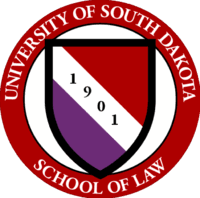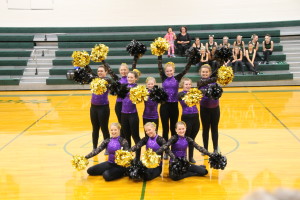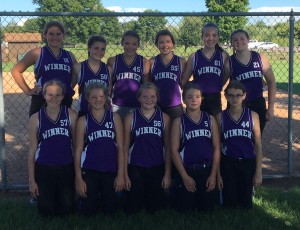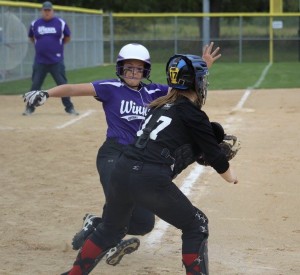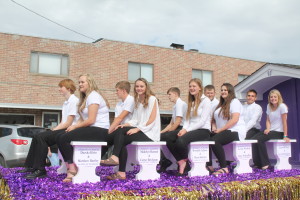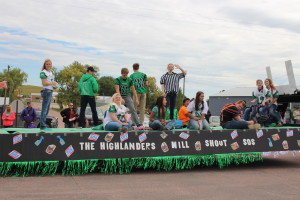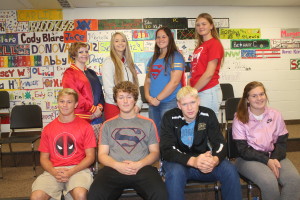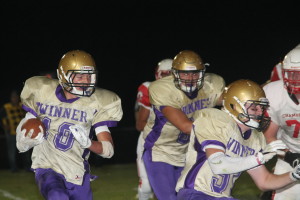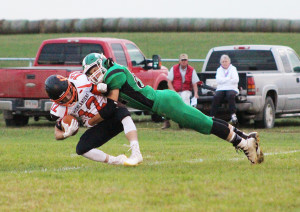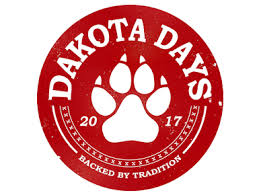
Fall is when Canada geese return to warmer climates and college graduates to their alma mater.
Homecoming is a week of alumni recognition, parades, football games, fun and memories.
The forerunner of Hobo Day at South Dakota State University in Brookings was a nightshirt parade.
Men dressed in nightshirts and women dressed in sheets gathered around a bonfire to rouse enthusiasm for a football game against Dakota Wesleyan the next day, according to “The College on the Hill” by Amy Dunkle with V.J. Smith. Led by the band, students carrying torches wound their way through town to the train station to meet the incoming football team. The students met with disappointment, as the Wesleyan football team was delayed and did not arrive until the following morning. State won the football game.
College authorities deemed it inappropriate for women students to roam the streets of Brookings draped in sheets, and suggested there be one great event rather than nightshirt parades.
According to information from the Hobo Day Committee, the biggest one-day event in the Dakotas started with several students eating ice cream at a local drug store and talking about ways to rescue a faltering student spirit. A student by the name of R. Adams Dutcher brought up a concept that had failed at the University of Missouri. This idea that caught fire at SDSU was one in which men dressed as hoboes and the women as American Indians. Thus, Hobo Day came into existence.
In 1939, Flandreau farmer Fred Weigel gave the Students’ Association a 1912 Model T Ford with the understanding that it appear each year in the Hobo Day parade. It has. The year the car was made was the same year the Hobo Day tradition began.
Robert Slagle was instrumental in starting homecoming at SDSU and the University of South Dakota. Slagle served as president of SDSU from 1906 to 1914, and took the concept of Hobo Days with him when he became president of USD in 1914.
“When he came to USD one of the things he wanted to do was strengthen the relationship between the university and the community. He suggested an event called South Dakota Day,” said Kersten Johnson of Pierre, who served as executive director of the USD Alumni Association from 2008 to 2016.
South Dakota Day is now called Dakota Days or D-Days.
Alumni achievement awards, open houses at different colleges, a reunion of marching band members, decorating fraternities and sororities, community service projects, a parade and football game are all part of D-Days activities. Artists have exhibits in the Gallery of Fine Arts.
The crowning of a homecoming queen, Miss Dakota, has been part of homecoming events since its beginning. In 1986, Karl Adam was crowned the first Dakota Day king, Mr. Dakota. The senior political science major from Pierre was the son of a Miss Dakota, Pat (Mickelson) Adam.
Al Neuharth, the founder of USA Today and The Freedom Forum, was one alumnus who came back to USD during Dakota Days.
“The whole crux of the week is for alumni to come back and give lectures and meet students and professors,” Johnson said. “They can retrace their steps on the campus they knew and the campus that has evolved. It’s amazing how transformative those four years are in a person’s lifetime. The thrill of coming home never changes.”
SDSU’s homecoming also played a role in the start of homecoming at Northern State University in 1916. According to an article in the Aberdeen American News by Cara Ball, Northern student Charles Fleischman and Aberdeen businessman Charles Creed reasoned that if SDSU could have Hobo Day, Northern could have Gypsy Day. Creed is credited with naming the event when gypsies came through his cigar store.
In 1919, Gypsy Day activities took place in May after being postponed due to the influenza epidemic at the beginning of the school year. Gypsy Day activities that year included the crowning of a queen, parade, baseball game, sports carnival, outdoor dinner and the presentation of the musical comedy “The Gypsy Rover.”
The Gypsy Day parade is called “The largest parade in South Dakota.” People crowd the parade route whether it’s raining, snowing or 90 degrees.
For eight years at Black Hills State University in Spearfish, homecomings were celebrated under such names as Gypsy Day, Pioneer Day and Paha Sapa Day. The Spearfish Normal football team was known only as the Normal team. That changed in 1928.
In “The Friendly College: The First 100 Years of Black Hills State College 1883-1983,” BHSU band director Mark Richmond explained the origin of the college’s homecoming.
In 1927, the Spearfish Normal football team played its archrival, the Hardrockers from the South Dakota School of Mines & Technology. The Normal football players were wearing long yellow coats over their uniforms.
One of the coeds, said to be Bessie Kennedy, yelled, “Go, you yellow jackets, go!” The cry was taken up by other fans. The team responded to the cheering, went after the Hardrockers like yellow jackets after someone who had disturbed their nest, and won the game.
The name Yellow Jackets became associated with BHSU athletic teams. BHSU held its first Swarm Day in the fall of 1928.
Richmond explained that BHSU’s homecoming was called Swarm Day because bees swarm and yellow jackets have similarities with bees. “So why should not old grads and other friends swarm back to BHSC every homecoming?” he is quoted as saying.
Festivities at Swarm Days include a hike up to the “H” on Lookout Mountain, an alumni awards lunch, a hall of fame banquet, coronation of a king and queen, burning of the “BH,” parade, tailgate social and football game.
The first homecoming at Eastern State Teachers College in Madison, now Dakota State University, took place in October 1922. Among the Pioneer Day activities were a barbeque, parade and the crowning of a homecoming queen, Gladys Meade of Fedora. The name of the homecoming celebration has changed over the years to Eastern Frontier Day, Eastern Day, Homecoming, Tutor Day and, in the 1970s, to the current Trojan Days.
Eastern Day on Oct. 19, 1926, was recorded in a documentary film staged by Eastern State Teachers College about the early history of South Dakota and the life of Gen. William Henry Harrison Beadle in South Dakota. The documentary “Dacotah” was the first of its kind filmed in the United States.
“To me, events like Trojan Days are important because they served to promote collegiality among university staff and students,” said Ryan Burdge, archivist at the Karl Mundt Library at DSU. “These days when our enrollment is increasingly online-only students, and many staff and faculty are commuters or telecommuters, it is important that events like these exist to preserve a notion of community that connects with our past.”
Rapid City residents had spy glasses, opera glasses and binoculars to view activities taking place on Cowboy Hill, a large slope on the west side of the city, on Oct. 5, 1912.
South Dakota School of Mines & Technology President Dr. Cleophas O’Harra had given students a holiday and, under the supervision of faculty, 65 young men were using stones to build an immense “M” on Cowboy Hill. At 112 ½ by 67 feet, it was hailed as the largest letter in South Dakota, according to “Centennial: An Illustrated History 1885-1985 South Dakota School of Mines and Technology.”
The rocks were whitewashed and it was said that the white M could be seen from 12 miles away.
The M-Day climb to the top of Cowboy Hill became an annual event. A morning of whitewashing the rocks and burning or pulling the weeds was followed by picnicking and dancing. Concrete later replaced the rocks. Football only became part of the tradition years later.
In 1934, mathematics professor Guy March called for a meeting of Mines graduates at his home in Rapid City. At that meeting the Alumni Association was reactivated and officers were elected. In October 1934, the first edition of The Hardrock alumni newspaper was published. It announced the forming of the Alumni Association and gave information on the first homecoming.
The Hardrock reported, “The annual Homecoming Day, ‘M’ day, will be the one big event each year. This year there was a total registration of over 100 alumni and former students.”
The day featured a free meal, the climbing of Cowboy Hill, a parade and a banquet at the Alex Johnson Hotel.
In 1936, M-Day was a day unto itself; the actual homecoming took place on Oct. 10. Homecoming activities began with an alumni meeting at the Alex Johnson Hotel and was followed by a homecoming parade with 75 decorated floats and cars going through downtown Rapid City.
At the 1960 homecoming, March reported that “over one-fourth of the living alumni attended … must be some kind of record.”
The first M-Day Queen was chosen in 1958, and was a high school student, Phyllis Gramm of Roscoe. It wouldn’t be until 1962 that an SDSM&T coed would reign over homecoming activities, when freshman Cheryl Harrelson was crowned M-Day Queen. Cindy Davies of the Devereaux Library at Mines explained that Mines had few women students until the 1960s. In those years, various campus organizations sponsored queen candidates. The candidates were wives of students, nursing students from the hospital, sisters of students and others.
Rocker Days at Mines combines homecoming activities with other traditions, including the M-Hill climb, the M-Day parade and – of course – football.
This moment in South Dakota history is provided by the South Dakota Historical Society Foundation, the nonprofit fundraising partner of the South Dakota State Historical Society at the Cultural Heritage Center in Pierre. Find us on the web at www.sdhsf.org. Contact us at info@sdhsf.org to submit a story idea.
